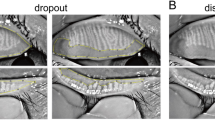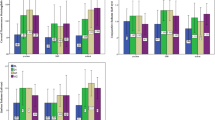Abstract
Purpose
To evaluate the correlation between clinical tests, patient symptoms, and conjunctivochalasis in contact lens wearers and non-wearers.
Methods
This study comprised 40 eyes of 40 current soft contact lens users and 40 eyes of 40 control subjects. Cross-sectional areas of conjunctivochalasis at three locations (nasal, central, temporal) during straight and downward gazes were determined using anterior segment optical coherence tomography in all participants. Tear film break up time test and Schirmer test with anesthesia were performed and for evaluation of symptoms, the participants completed ocular surface disease index questionnaire.
Results
During straight gaze, the mean cross-sectional areas of conjunctivochalasis were 0.0112 ± 0.009 and 0.006 ± 0.005 mm2 at nasal, 0.0096 ± 0.007 and 0.002 ± 0.004 mm2 at central, 0.0176 ± 0.014 and 0.008 ± 0.009 mm2 at temporal in contact lens and control groups, respectively. Regardless of location and gaze direction, the mean cross-sectional conjunctivachalasis areas of the contact lens group were significantly higher than those of the controls (all, p < 0.05). Significant positive correlations between ocular surface disease index score and measured conjunctivachalasis areas (in all sites) during straight gaze and downward gaze were observed in the contact lens group (all, p < 0.05 and r > 0.450).
Conclusion
Wearing soft contact lenses is associated with increased conjunctivochalasis areas. Anterior segment optical coherence tomography determined conjunctivochalasis area is an objective clinical measurement value that is positively correlated with patients’ symptoms in soft contact lens wearers.

Similar content being viewed by others
References
Meller D, Tseng SC (1998) Conjunctivochalasis: literatüre review and possible pathophysiology. Surv Ophthalmol 43(3):225–232. https://doi.org/10.1016/s0039-6257(98)00037-x
Dalianis G, Trivli A, Terzidou C (2018) The location of conjunctivochalasis and its clinical correlation with the severity of dry eye symptoms. Medicines 5(1):E12. https://doi.org/10.3390/medicines5010012
Di Pascuale MA, Espana EM, Kawakita T, Tseng SC (2004) Clinical characteristics of conjunctivochalasis with or without aqueous deficiency. Br J Ophthalmol 88(3):388–392. https://doi.org/10.1136/bjo.2003.025460
Acera A, Vecino E, Duran JA (2013) Tear MMP-9 levels as a marker of ocular surface inflammation in conjunctivochalasis. Invest Ophthalmol Vis Sci 54(13):8285–8291. https://doi.org/10.1167/iovs.13-12235
Marmalidou A, Kheirkhah A, Dana R (2018) Conjunctivochalasis: a systematic review. Surv Ophthalmol 63(4):554–564. https://doi.org/10.1016/j.survophthal.2017.10.010
Lim CHL, Stapleton F, Mehta JS (2018) Review of contact lens-related complications. Eye Contact Lens 44(2):S1–S10. https://doi.org/10.1097/ICL.0000000000000481
Morgan PB, Efron N (2008) Demographics of UK contact lens prescribing. Cont Lens Ant Eye 31(1):50–51. https://doi.org/10.1016/j.clae.2007.11.005
Doughty MJ, Fonn D, Richter D, Simpson T, Caffery B, Gordon K (1997) A patient questionnaire approach to estimating the prevalence of dry eye symptoms in patients presenting to optometric practices across Canada. Optom Vis Sci 74(8):624–631. https://doi.org/10.1097/00006324-199708000-00023
Kojima T (2018) Contact lens-associated dry eye disease: recent advances worlwide and in Japan. Invest Ophthalmol Vis Sci 59(14):DES102–DES108. https://doi.org/10.1167/iovs.17-23685
Guillon M, Maissa C (2005) Bulbar conjunctival staining in contact lens wearers and non lens wearers and its association with symptomatology. Cont Lens Ant Eye 28(2):67–73. https://doi.org/10.1016/j.clae.2005.02.002
Pflugfelder SC, de Paiva CS (2017) The pathophysiology of dry eye disease: what we know and future directions for research. Ophthalmology 124(11S):S4–S13. https://doi.org/10.1016/j.ophtha.2017.07.010
Gumus K, Crockett CH, Pflugfelder SC (2010) Anterior segment optical coherence tomography: a diagnostic instrument for conjunctivochalasis. Am J Ophthalmol 150(6):798–806. https://doi.org/10.1016/j.ajo.2010.06.014
Mimura T, Usui T, Yamamoto H, Yamagami S, Funatsu H, Noma H, Honda N, Fukuoka S, Amano S (2009) Conjunctivochalasis and contact lenses. Am J Ophthalmol 148(1):20–25. https://doi.org/10.1016/j.ajo.2009.02.018
Hughes WL (1942) Conjunctivochalasis. Am J Ophthalmol 25:48–51. https://doi.org/10.1016/S0002-9394(42)93297-5
Li QS, Zhang XR, Zou HD, Peng JJ, Shi CC, Zhou HM, Zhang GL, Xiang MH, Li YJ (2009) Epidemiologic study of conjunctivochalasis in populations equal or over 60 years old in Caoyangxincun community of Shanghai. China Zhonghua Yan Ke Za Zhi 45(9):793–798
Mimura T, Usui T, Yamagami S, Funatsu H, Noma H, Toyono T, Mori M, Amano S (2011) Relationship between conjunctivochalasis and refractive error. Eye Contact Lens 37(2):71–78. https://doi.org/10.1097/ICL.0b013e31820ca377
Ward SK, Wakamatsu TH, Dogru M, Ibrahim OM, Kaido M, Ogawa Y, Matsumoto Y, Igarashi A, Ishida R, Shimazaki J, Schnider C et al (2010) The role of oxidative stress and inflammation in conjunctivochalasis. Invest Ophthalmol Vis Sci 51(4):1994–2002. https://doi.org/10.1167/iovs.09-4130
Guillon M, Maissa C (2008) Contact lens wear affects tear film evaporation. Eye Contact Lens 34(6):326–330. https://doi.org/10.1097/ICL.0b013e31818c5d00
Nichols JJ, Sinnott LT (2006) Tear film, contact lens, and patient-related factors associated with contact lens-related dry eye. Invest Ophthalmol Vis Sci 47(4):1319–1327. https://doi.org/10.1167/iovs.05-1392
Gilbard JP, Gray KL, Rossi SR (1986) A proposed mechanism for increased tear-film osmolarity in contact lens wearers. Am J Ophthalmol 102(4):505–507. https://doi.org/10.1016/0002-9394(86)90081-4
Kocabeyoglu S, Mocan MC, Irkec M, Orhan M, Karakaya J (2014) Conjunctivochalasis as a contributing factor for the development of ocular surface disease in medically treated glaucoma patients. J Glaucoma 23(5):333–336. https://doi.org/10.1097/IJG.0b013e3182741f32
Chhadva P, Alexander A, McClellan AL, McManus KT, Seiden B, Galor A (2015) The impact of conjunctivochalasis on dry eye symptoms and signs. Invest Ophthalmol Vis Sci 56(5):2867–2871. https://doi.org/10.1167/iovs.14-16337
Gumus K, Pflugfelder SC (2013) Increasing prevalence and severity of conjunctivochalasis with aging detected by anterior segment optical coherence tomography. Am J Ophthalmol 155(2):238-242.e2. https://doi.org/10.1167/iovs.14-16337
Thai LC, Tomlinson A, Doane MG (2004) Effect of contact lens materials on tear physiology. Optom Vis Sci 81(3):194–204. https://doi.org/10.1097/00006324-200403000-00012
Pult H, Purslow C, Murphy PJ (2011) The relationship between clinical signs and dry eye symptoms. Eye (Lond) 25(4):502–510. https://doi.org/10.1038/eye.2010.228
Pult H, Purslow C, Berry M, Murphy PJ (2008) Clinical tests for successful contact lens wear: relationship and predictive potential. Optom Vis Sci 85(10):E924–E929. https://doi.org/10.1097/OPX.0b013e3181888909
Gan JY, Li QS, Zhang ZY, Zhang W, Zhang XR (2017) The role of elastic fibers in pathogenesis of conjunctivochalasis. Int J Ophthalmol 10(9):1465–1473. https://doi.org/10.18240/ijo.2017.09.21
Otaka I, Kyu N (2000) A new surgical technique for management of conjunctivochalasis. Am J Ophthalmol 129(3):385–387. https://doi.org/10.1016/s0002-9394(99)00384-0
Funding
None of the authors has a financial and proprietary interest in any material or method mentioned and there is no public or private support.
Author information
Authors and Affiliations
Contributions
All authors contributed to writing of main manuscript text and all authors reviewed the manuscript, tables and figure.
Corresponding author
Ethics declarations
Conflict of interest
The authors have not disclosed any competing interests.
Additional information
Publisher's Note
Springer Nature remains neutral with regard to jurisdictional claims in published maps and institutional affiliations.
Rights and permissions
Springer Nature or its licensor (e.g. a society or other partner) holds exclusive rights to this article under a publishing agreement with the author(s) or other rightsholder(s); author self-archiving of the accepted manuscript version of this article is solely governed by the terms of such publishing agreement and applicable law.
About this article
Cite this article
Aslan Bayhan, S., Erkan, E., Bozbay Erkan, F. et al. Clinical correlations and ımpact of conjunctivochalasis in soft contact lens wearers. Int Ophthalmol 44, 39 (2024). https://doi.org/10.1007/s10792-024-02936-x
Received:
Accepted:
Published:
DOI: https://doi.org/10.1007/s10792-024-02936-x




